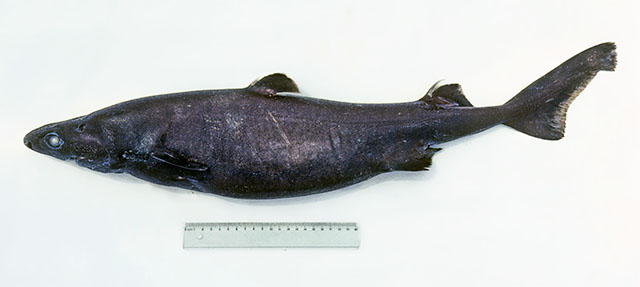| Etmopteridae (Lantern sharks) |
| 86 cm TL (male/unsexed); max.weight: 3,620.0 g |
|
pelagic-oceanic; marine; depth range 220 - 1620 m |
| Indian Ocean, Southern Pacific and Southern Atlantic (Ref. 106604). Reported from off the western Cape coast but the identity of South African specimens is questionable (Ref. 127434). |
|
Dorsal spines (total): 2-2; Dorsal soft rays (total): 0-0; Anal spines: 0-0; Anal soft rays: 0-0. A large, heavy-bodied lanternshark with a big head (Ref. 5578), bladelike unicuspidate teeth in lower jaw and teeth with cusps and cusplets in upper jaw, stocky body, conspicuous lines of denticles on body, conspicuous black markings on underside of body and tail, with tail marking short and not extending far posteriorly (Ref. 247). Dark brown or black in color, possibly darker below (Ref. 26346). |
| Found on outermost continental shelves and upper slopes (Ref. 247). Feeds on bony fishes including lanternfish, barracudina, synaphobranchid eels, oreo dories, hake, rattails, bathylagids, idiacanthids; also on squids (including histioteuthids and ommastrephids), octopuses, euphausiids, mysids, penaeid shrimp, salps, sponges and ribbonworms (Nemertina) (Ref. 124555). Bioluminescence observed, with the dorsal photophores, flank markings, and brighter pectoral fin and claspers are likely to be used for intraspecific communications and the ventrally emitted light is likely to be used for counterillumination (Ref. 123656). Ovoviviparous (Ref. 205), with 10-13 in a litter, size at birth about 18 cm (Ref. 6871) to possibly 30 cm (Ref. 124555), Minimum depth reported taken from Ref. 247. |
|
Least Concern (LC); Date assessed: 02 July 2017 Ref. (130435)
|
| harmless |
Source and more info: www.fishbase.org. For personal, classroom, and other internal use only. Not for publication.
